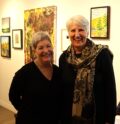Headline News
South Algonquin discusses and passes its 2021 budget
April 14, 2021
By Mike Riley
Local Journalism Initiative Reporter
At their April 7 meeting, South Algonquin council discussed some amendments to the draft budget that was presented at the March council meeting. After a brief presentation by Holly Hayes, the CAO/clerk-treasurer, and a discussion by council, Hayes concluded by saying that despite the changes since March, the budget had stayed the same and the proposed mill rate increase remained unchanged at one per cent. Later on in the meeting, council passed the bylaws to bring the 2021 budget into effect.
Hayes had given a detailed presentation to council of the draft budget during the March 3 council meeting. Overall, the 2020 township levy was $2,432,806 while they require a levy of $2,457,135 to balance the budget for 2021. That difference amounts to $24,329, which would necessitate a one per cent tax increase. With that one per cent increase, a property with a CVA of $150,000 would see an increase of $13 a year on their tax bill, while a property with a CVA of $200,000 would see a $17 a year increase. The education tax rate remains unchanged from last year, so there is no increase for 2021.
Full details on the draft budget presentation are included in the March 17 Bancroft Times article “South Algonquin 2021 draft budget presented” or look for the March 3 council meeting at the South Algonquin Township website, www.southalgonquin.ca/council under the heading “council meetings on YouTube.”
Hayes and staff had invited council to make any suggestions or changes in the weeks leading up to the April council meeting, which they did.
Hayes commented in a March 11 email that the process of drafting the budget is getting better and staff had done a lot of work over the past years to improve and standardize the budget.
“Staff create the budget based on the information we have available including all the anticipated revenue and expenses, part of the process is council increasing, decreasing, or changing based on what they think is best. So, the process is really created for continued change until it’s passed. I think the public perception is that staff should be offended or begrudge changes, when the reality is that we are doing our best to initiate the conversation and the process will go where it needs to,” she says.
At the April 7 council meeting, Mayor Jane Dumas asked Hayes to present the amendments to the draft budget that had been put in place since the March council meeting. Hayes began by reminding everyone that she’d presented the draft budget for 2021 at the last council meeting, and over the last month, a little bit of information and some changes had come back from council.
Hayes began by mentioning DRAPE imagery, which is their Geographical Information System, a framework for gathering, managing and analyzing geographical data, a fund in the amount of $3,800. DRAPE stands for Digital Rastor Acquisition Project for East imagery, and is a digital mapping project of 54,000 square kilometres of eastern Ontario.
“We put it in the last two budgets and it didn’t show up. They kept delaying it and I didn’t put it in this budget. I put it in reserve and lo and behold, it showed up,” she says.
Therefore, it was added to the budget, but Hayes said it won’t change the bottom line as it will be coming in from reserves and paying for the mapping project.
Hayes said they had reduced the salary and wage grid to an increase of only 1.1 per cent, which she said is the GDP for Ontario as of January, 2021.
“So that amount has been reduced from two per cent,” she says.
Some post budget preparation work was undertaken by Hayes and staff with regard to a council resolution at the March council meeting to undertake some improvements on Shields Road.
“Because that was passed, we put the information, some of that reserve was transferred and added $10,000 to the transportation capital budget. As a result, the contribution to reserve has been decreased by that amount,” she says.
Hayes also mentioned that additional budget discussions had suggested the township undertake a DNSSAB property purchase.
“I think that’s the kind of thing if we move forward and are successful with that project that will be a resolution that council can bring funding out of reserves to do that. I don’t think putting that in the budget this year, not really knowing if its going to happen is really necessary, but there is reserve there if we need it,” she says.
A design was being done for Hay Creek Road, according to Hayes. She said it had been suggested that the snowmobile bridge be taken out, which she pointed out was a maintenance thing they could do as part of the drainage project to be undertaken.
Hayes said sand for the Whitney volleyball court was also available and could be done through the operations budget.
Hayes said that the money for the dry hydrants had been left in the budget.
“So, we’ll work with council in the next little while to determine the locations of those hydrants. I know councillors have suggestions and good information on where those hydrants should go,” she says.
Hayes said that the road signage project would be included within the roads needs study, and they would also be getting a signage document as part of the whole project.
There had been some interest in some fitness equipment being acquired in Madawaska or turning the baseball diamond in Madawaska into a walking track, according to Hayes.
“We should talk to the people of Madawaska and see what it is they want. Maybe put that out there as a survey to see what people want,” she says.
Hayes went on to say there was money in the recreation reserves that could be pulled if and when this project goes forward.
“So, those are the changes that have happened since the March council meeting. The budget has stayed the same, the proposed mill rate increase has also stayed the same [at one per cent],” she says.
Mayor Jane Dumas commended Hayes and staff for a very fulsome process in the budgeting process.
“The stringent and overriding objectives of maintaining the core services of South Algonquin and for the residents of South Algonquin. And yet, we are cognizant that taxpayers are the source of our revenue,” she says.
Dumas mentioned that there was a message from MPAC that when they are able to get around to doing their property assessments, taxpayers should expect an increase in the next year or so, since MPAC was currently going by its 2016 assessments, due to COVID-19.
Councillor Joe Florent also reiterated this, saying that sooner or later, property owners could expect a fairly dramatic increase.
Dumas added that municipal governments have no control over what MPAC assesses and the outcoming tax rate that arises from that.
“So, remember that and I think you’ll hear us mentioning this to the general public frequently because there will be an increase at some point down the road in municipal taxes due to the MPAC assessment,” she says.
Dumas concluded by thanking Hayes and staff for an excellent budget and said that they should be proud that South Algonquin is in a really strong financial situation.
“Compared to neighbouring municipalities that are having increases of anywhere between 2.5 per cent to over four per cent, I think South Algonquin is doing a good job,” she says. “Thank you to council and staff for your diligence in this process.”
Later on in the council meeting, council voted to pass the 2021 budget unanimously, bringing it into effect.

















